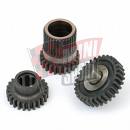The Modis is a professional diagnostic tool that lets you pinpoint and diagnose today’s sophisticated vehicles faster. This scan tool is the standard of the industry and rightfully so. We used one of the early Modis Sacn tools in my shop. I do not recommend it for home use since it cost about ten thousand dollars..
Although not many transmission suppliers use tools like this to insure every unit sold is 100% healthy, companys like GotTranmsissions.com use them to test every transmission for defects before it gets shipped. One reason the rate of problems with transmissions supplied by GotTransmissions.com is less than 5%. And that is low..
The highly technological system incorporates advanced OBD (on-board diagnostic) capabilities including Domestic and Asian Import Vehicle Communication Software, plus a cool feature for instant diagnosis, called Fast-Track Troubleshooter; it actually combines software that integrates experience-based information with scan tool instrumentation solutions. The MODIS system also features a powerful 4-channel lab scope with multiple secondary ignition capabilities and a powerful Digital Graphing Multimeter built into it.
Fast-Track Component Tests combine MODIS scope and DVOM (digital volt ohm meter) instrumentation with information direct from factory-trained and ASE-certified master technicians to quickly locate, connect, test, and troubleshoot components. It’s a hand-held with everything you need for today and tomorrow.
The particular scanner system gives you fast one stop access to Domestic and Asian Import Vehicle Communication Software, supported by the Snap-On tools. Add to this a fast 4-channel lab scope, digital graphing multimeter, and Fast-Track itemized component tests and you are the fastest techin the shop. (and the poorest)!
The rest of the information on this tool probably means nothing to most folks. But what I have just said about this tool and comparable ones is one reason a good diagnosis is worth the hour worth of labor that a compentent transmission shop might charge you. FYI, at my shop, we diagnosed for free, no charge, no obligation. It was a courtesy to who ever stopped in for work.
I could go on and on ‘hipping’ you up to the really cool diagnostic tools available through many companies, but I think perhaps that is for future posts. Our point at GotTransmissions.com Blog is this:…it is much more cost effective with a sucessfull outcome paying the diagnosis fee (which in some cases is absorbed by the shop upon repair) than to arbitrarily change parts. For instance, buying a 700.00 dollar computer, when you had a fourty dollar bad part.
Lets see…$80.00 dollars to diagnose and $40.00 dollars for a part and $75.00 dollars labor is $195.00, which beats a $700.00 onboard computer that did not fix the problem..I hope you lighten up on your mechanic now. He paid a lot of money for the tool and his years of experience are priceless.
GotTransmissions.com—866-320-1182…






